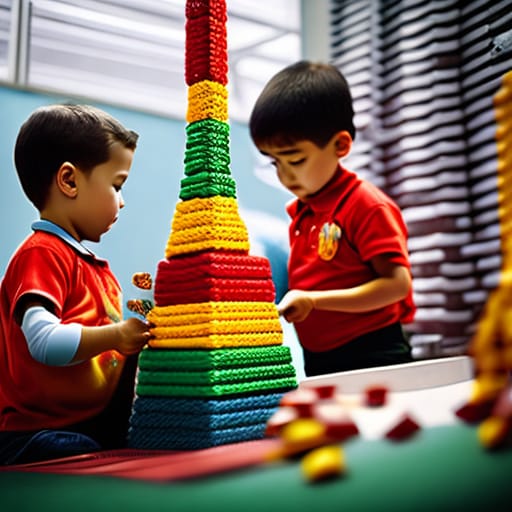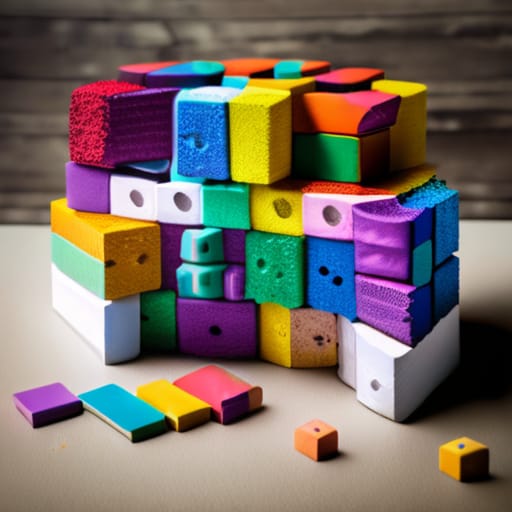Building toy blocks have been a beloved children’s toy for generations. These simple colored blocks inspire creativity, imagination, and vital skills in young minds. This beginner’s guide will explore the significance of building blocks, market trends, innovations, safety considerations, and more. Whether you’re a parent, educator, or nostalgic adult, read on to learn all about the wonderful world of building toy blocks!
A Brief History of Building Blocks
Building blocks trace their origin to simple wooden alphabet blocks in the 1800s. The first interlocking blocks using mechanisms like notches and knobs were patented in England in 1847. In the early 1900s, manufacturers began producing building blocks made of rubber, stone, and ceramics.
The most iconic building toy block – the LEGO brick – was created in 1958. These interlocking plastic bricks revolutionized the industry and remain one of the world’s most popular children’s toys today. Brands like Mega Bloks later followed with compatible plastic bricks. Wood still remains a classic block material appreciated for its versatility and sustainability.
Over the decades, building blocks have continued to evolve with innovations like magnets, wheels, figures, and even motors. Today they inspire open-ended creativity or model specific structures like castles, trains, and cities. Read on to learn more about the many varieties of building blocks on the market.
Types of Building Toy Blocks
There are several major categories of blocks that encourage constructive play:
Traditional Unit Blocks
These classic wooden blocks in geometric shapes allow for open-ended building activities.
- Common shapes: squares, rectangles, triangles, cylinders
- Sized for easy grasping by small hands
- Often made of durable hardwoods like maple or oak
- No connectors – stacked by balance
Interlocking Blocks
Plastic blocks like LEGO snap together via connectors to build elaborate structures.
- Varying sizes, shapes, colors
- Themed kits for models like trains, buildings
- Licensed kits featuring TV shows, movies
- More possibilities but less open-ended
Magnetic Blocks
Colorful plastic blocks embed magnets to offer new building possibilities.
- Shapes stick together from all sides and at angles
- Develop spatial reasoning and introduce physics
- Can be expensive but reusable for years
Jumbo and Foam Blocks
Lightweight oversized blocks suit younger toddlers best.
- Soft textures and rounded edges for safety
- Great for practicing motor skills
- Most can be wiped clean easily
- Less detailing than small blocks
The options allow kids to progress in skills and suits different learning styles. Many children start with simple chunks and work up towards more complex interlocking shapes. Adult guidance helps bridge play between different types of blocks.
Why Are Building Blocks Beneficial?
Child development experts agree that playing with building blocks offers immense benefits for young children.
- Foster creativity & imagination – Invent open-ended structures like spaceships, bridges
- Build fine motor, spatial, and logic skills needed for later STEM subjects
- Allow experimenting with physics concepts like balance, gravity early
- Promote planning, problem-solving through testing and revising structures
- Provide opportunities for collaborative teamwork on group projects
- Boost self-esteem and independence through completing builds
Most importantly, blocks offer endless hands-on fun while kids learn! Starting block play early helps build crucial skills during prime developmental windows.
“Children who repeatedly explore and experiment with blocks may have greater ease in understanding mathematics, science, and even literacy later on.” – Dr. Kyle Pruett, Clinical Professor of Child Psychiatry
The American Academy of Pediatrics recommends avoiding digital toys for toddlers, making classic building blocks the perfect screen-free activity. Versatility also allows blocks to adapt as kids grow for years of enjoyment.
Selecting Building Blocks
With so many options on the market, choosing the right beginner blocks for your child can get confusing. Here are top factors to consider:
Child’s Age
- Infants & young toddlers – Soft chunky foam/cloth blocks
- 1-3 years – Jumbo wooden blocks or mega blocks
- 3+ years – Smaller interlocking blocks
Safety
- Round edges, no detachable or loose parts
- BPA-free materials
- Test stability of structures
Versatility
- Open-ended is great for early creativity
- Themed kits allow replicating structures
- Mix materials like wood, plastic & magnets
Durability & Value
- Seek quality materials to withstand use
- Weigh cost per block vs. longevity
Storage
- Look for bins/bags to keep blocks organized
- Low shelves or carts accessible for kids
While all block play nurtures development, tailor choices based on your child’s evolving abilities and needs. Add to the variety of blocks over time to hold interest.

Top Rated Building Blocks
Thousands of building block products exist, but these remain longtime favorites across ages:
For Toddlers
- Edushape Rainbow Chunky Blocks – $29.99
- Melissa & Doug Jumbo Knob Wooden Building Blocks – $21.99
For Preschoolers
- Magna-Tiles Clear Colors 100 Piece Set – $119.95
- LEGO Classic Large Creative Brick Box – $59.99
For School Age Kids
- K’Nex – Imagine 40 Model Building Set – $29.99
- LEGO Creator 3-in-1 Cruising Adventures Set – $19.99
Balancing price, versatility, safety, and value, the above sets earn widespread positive feedback. Reading customer reviews helps determine if a product suits your needs. Most importantly, ensure your child feels joy and pride while building!
Getting the Most From Block Play
You’ve got the blocks – now how can kids get the most developmental benefits from constructive block play? Follow these tips:
- Foster intrinsic motivation – Let kids experiment rather than giving step-by-steps
- Ask open questions as they build structures
- Add simple constraints to promote creativity
- Balance independent playtime with engaged family block time
- Introduce math and science vocabulary while building together
- Capture photos of block creations to celebrate problem solving skills
- Display structures proudly before disassembling and starting anew!
Structured block exercises exist, but unstructured exploration aids early development best. As children gain skills, they’ll graduate towards replicating challenging structures.
Developing Block Skills By Age
Tailor expectations and guidance based on your child’s evolving abilities:
1-2 Years: Focus is grasping blocks in each hand, pounding together, taking apart, feeling textures and weights.
2-3 Years: Stacking 4-6 blocks vertically or in towers, arranging in lines, balancing with precision. Add simple vocabulary.
3-4 Years: Spans 6-10 blocks, experiments with balance, early problem-solving, incorporates pretend play themes, cooperates on group projects.
4-5 Years: Builds Eiffel Tower replicas up to 15 blocks tall, collaborates in role play stories with structures, starts following visual building instructions.
Staying patient, offering praise, and capturing proud moments on camera matters more than perfect structures! With time, block skills develop rapidly.
Safety First!
While blocks inspire creativity, establishing a safe environment prevents avoidable accidents:
General Safety
- Supervise young toddlers and set reasonable limits
- Ensure structures are built on flat, stable surfaces
- Test balance and reinforce wobbly structures
- Store blocks on low, labeled shelves accessible to kids
- Monitor small and detached block pieces
- Watch for top-heavy towers at risk of collapsing
- Ensure kids don’t throw blocks or hit each other
Cleaning and Maintenance
- Wash hands before and after play
- Sanitize wood, plastic, and foam blocks regularly
- Check blocks for damage and discard broken pieces
- Avoid leaving blocks out in extreme weather
- Follow manufacturer storage recommendations
Staying attentive and coaching kids on safe construction prevents chaotic scenes of toppling block towers! Establishing orderly habits early keeps the fun flowing.

Bringing Blocks Into the Classroom
Beyond home use, building blocks offer versatile learning tools applicable across preschool and early elementary curriculum.
Literacy – Label wooden block alphabet letters, build scenes from favorite stories
Math – Explore shapes, patterns, sorting, counting, addition/subtraction, fractions
Science – Test concepts like gravity, friction, motion down ramps
Social Studies – Construct global landmarks like pyramids or model communities
Art – Arrange and glue block structures then paint for 3D masterpieces!
Physical Education – Use large soft blocks for obstacle courses to climb over, around, under & through
Music – Make your own instruments tapping blocks or shaking them in containers
Open-ended collaborative building ties multidisciplinary knowledge together while keeping students engaged. Early learner classrooms should be well-stocked with blocks that students can utilize in learning centers or small groups.
“Proper use of blocks can enable students to progress from concrete concepts to abstract principles and meaning across subjects.” – Mr. Andrew MacDonald, 2nd Grade Teacher
Educators can also motivate students through special block challenges, monthly building competitions, or assigned projects. Let those blocks roll!
Fostering Lifelong Building Skills
Beyond classrooms, building blocks instill skills that allow humans to construct our built world. Early block play builds spatial reasoning needed for architecture, engineering design thinking to solve problems, and team collaboration towards a shared vision.
In fact, many renowned builders, inventors, scientists, and thought leaders attribute their success to open-ended block play in childhood. The repetitive practice of imagining, planning, testing, and constructive iteration cannot be undervalued as a foundation.
So don’t limit your child to vanilla building block kits only. Offer a rotating variety of blocks in different shapes, textures, and connectivity options. Guide play towards storytelling, new challenges, and team builds. Then stand back and let those budding imaginations soar sky high! Who knows what incredible structures the future generation of innovators, thought leaders, and change makers will construct next?
We hope this beginner’s guide provided a solid introduction to the significance of building blocks in child development along with what to look for when selecting blocks. Remember to start simple and let your child lead the way following their innate curiosity. Building blocks might just build the foundation for the next generation of innovators!
Frequently Asked Questions
What are the best first blocks for babies?
Chunky soft blocks made of fabric or wood with rounded edges are safest for infants starting to grasp and mouth blocks. Prioritize large sizes babies can manipulate and textures they can explore.
When can babies start playing with blocks?
Blocks can enter play starting around 6 months old when babies begin understanding cause and effect. Offer supervision for safety and demonstrate simple stacking. Just don’t expect expert structures quite yet!
How do blocks help develop math skills?
Math concepts like sorting, patterns, organization, spatial awareness, geometry, symmetry, dimensions, counting, and fractions all integrate with block play. Having structured time to test concepts along with independent building fosters skills.
Should I buy generic blocks or kits with themes?
Seek a balance of both open-ended basic blocks along with some themed kits tailored to the child’s interests. Generic blocks allow endless creativity while theme kits provide structure for replicating. Mix materials too!
How can I integrate block play into preschool learning?
Incorporate blocks into interest areas like dramatic play, science, math manipulatives and art studios. Encourage collaboration on structures and assign challenges related to classroom themes or curriculum.
How do I get the most education value from blocks?
While free play matters most, also engage with kids while building. Ask guided questions, introduce new vocabulary, tie projects to classroom learning, pose challenges to extend skills, capture proud moments and display structures.
Are blocks still relevant with so much technology available?
Absolutely! While we now have dazzling digital games and toys, classic blocks build crucial developmental skills, creativity, and social-emotional learning unlike any tech toy. Hands-on blocks balance digital play beautifully!
